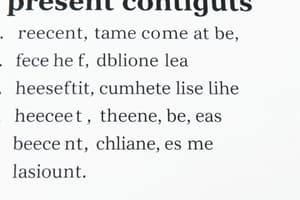Podcast
Questions and Answers
The present continuous tense is used to describe actions that are currently happening.
The present continuous tense is used to describe actions that are currently happening.
True (A)
The formula for the present continuous tense is Subject + have + verb(-ing).
The formula for the present continuous tense is Subject + have + verb(-ing).
False (B)
Present continuous tense can be used for future plans.
Present continuous tense can be used for future plans.
True (A)
Flashcards are hidden until you start studying
Study Notes
Present Continuous Tense
Definition
- The present continuous tense describes actions that are currently happening or ongoing.
Structure
- Formed using the verb "to be" + verb ending in -ing.
- Formula: Subject + am/is/are + verb(-ing)
Usage
-
Current Actions
- To describe actions happening at the moment of speaking.
- Example: "She is reading a book."
-
Temporary Actions
- For actions that are not permanent but are ongoing.
- Example: "They are living in London this year."
-
Future Plans
- To indicate planned future events.
- Example: "I am meeting my friend tomorrow."
-
Changing Situations
- To show that situations are changing over time.
- Example: "The weather is getting warmer."
Negative Form
- Structure: Subject + am/is/are + not + verb(-ing)
- Example: "He is not watching TV."
Question Form
- Structure: Am/Is/Are + subject + verb(-ing)?
- Example: "Are you coming to the party?"
Signal Words
- Often used with time expressions like:
- "now"
- "currently"
- "at the moment"
- "right now"
Common Mistakes
- Confusing with simple present tense.
- Remember that present continuous emphasizes ongoing actions, while simple present reflects habitual actions.
Summary
- The present continuous tense is essential for communicating actions in real-time, discussing temporary situations, and planning future events.
Definition
- Present continuous tense expresses actions that are currently occurring or ongoing.
Structure
- Constructed with the verb "to be" followed by a verb ending in -ing.
- Formula: Subject + am/is/are + verb(-ing)
Usage
- Current Actions
- Describes activities taking place at the moment of speaking, e.g., "She is reading a book."
- Temporary Actions
- Indicates actions that are not permanent but are still in progress, e.g., "They are living in London this year."
- Future Plans
- Utilized for indicating planned future events, e.g., "I am meeting my friend tomorrow."
- Changing Situations
- Highlights situations that are evolving over time, e.g., "The weather is getting warmer."
Negative Form
- Structure: Subject + am/is/are + not + verb(-ing)
- Example: "He is not watching TV."
Question Form
- Structure: Am/Is/Are + subject + verb(-ing)?
- Example: "Are you coming to the party?"
Signal Words
- Commonly paired with time expressions such as:
- "now"
- "currently"
- "at the moment"
- "right now"
Common Mistakes
- Confusing present continuous with simple present tense.
- Key distinction: Present continuous emphasizes ongoing actions, while simple present indicates habitual actions.
Summary
- Present continuous tense is crucial for communicating real-time actions, addressing temporary situations, and planning future events.
Studying That Suits You
Use AI to generate personalized quizzes and flashcards to suit your learning preferences.




